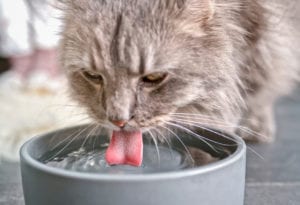How to Treat Polyuria and Polydipsia in Cats
As various factors change in a cat’s life, it’s common to see water intake and urination levels fluctuate to suit their current needs and environmental conditions. However, if you notice your furry friend drinking a lot more water or urinating more frequently, this could be a sign of an underlying health condition.
If your cat is making more frequent trips to the litter box or cleaning out its water bowl quicker than usual, these could be signs of polyuria or polydipsia. While polyuria and polydipsia themselves are not typically an immediate cause for concern, understanding these conditions and their causes are important in helping you determine if a visit to the vet is in order.
What is Polyuria and Polydipsia in Cats?
Polydipsia refers to a sharp increase in thirst levels. Polyuria is an increase in urination. While it can be challenging to identify polyuria or polydipsia in cats, the best way to recognize potential problems is to monitor your feline friend closely. Start by measuring the water that you pour into your cat’s bowl in the morning. On average, a healthy cat will take in roughly 20 to 40 milliliters of water per pound per day. By measuring your cat’s water supply at the start and end of each day, you can determine whether or not your furry friend is experiencing polydipsia.
One way to help identify polyuria in your cat is to observe the amount of wet litter inside of your cat’s litter box each day. In many cases, the cat might be experiencing an increase in urine volume caused by polyuria, and might also urinate outside the litter box. If you’re noticing more wet litter or an uncharacteristic change in your pet’s potty habits, it’s time to make a vet appointment right away.
Causes of Polyuria and Polydipsia in Cats
Many factors can lead to polyuria and polydipsia in cats. However, the primary causes include congenital abnormalities, specifically those related to renal failure. Additional causes of polyuria and polydipsia in cats include:
● Diabetes
● Kidney failure
● Uterine infection
● Liver disease
● Low protein diets
● Age
How to Treat Polyuria and Polydipsia in Cats
Treating polyuria and polydipsia in cats depends on a case-by-case basis, and is determined by the severity of the situation. The primary concern is that renal or hepatic failure could be the leading cause of polyuria or polydipsia. However, if both have been ruled out as possible causes, no treatment or significant life adjustment will likely be required for your furry friend.
By themselves, polyuria and polydipsia are not necessarily an initial cause for concern. However, if symptoms continue and are combined with other behavioral changes, make an appointment to have your cat evaluated by a veterinary professional right away.
Need a good vet? Visit AZPetVet.com/locations to find one near you!
[Disclaimer]
Not intended to be a substitute for professional veterinarian advice, diagnosis, or treatment. Always seek the advice of your veterinarian with any questions you may have regarding the medical condition of your pet. If you think your pet has a medical emergency, call or visit your veterinarian or your local veterinary emergency hospital immediately.


